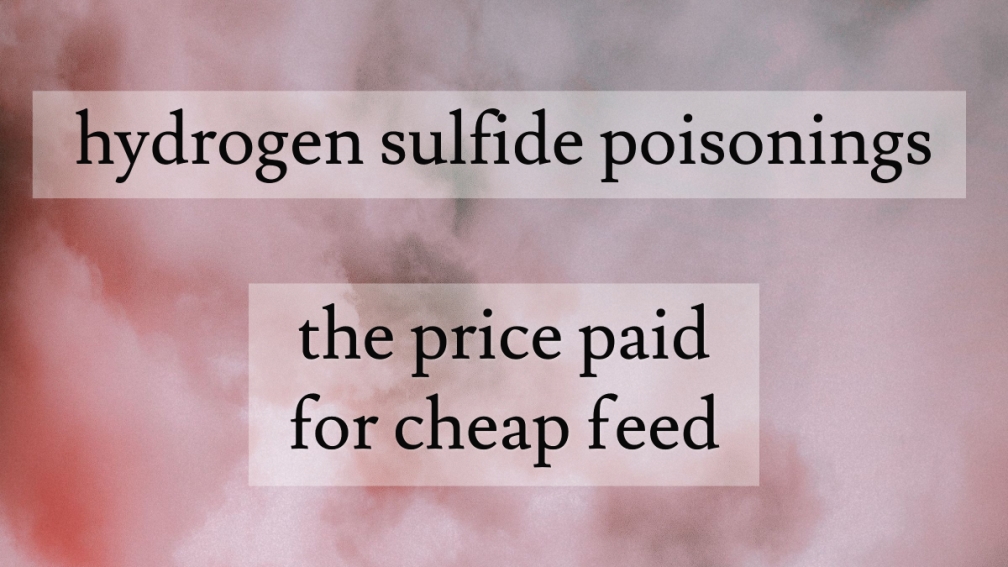Two employees died on 9/12/21 at the Valley Proteins rendering facility in Fayetteville, NC. Television station WRAL states “An employee at the plant told WRAL News that working in these settings can be risky. The employee, who asked to not be identified, said it’s likely the two employees found unresponsive were exposed to hydrogen sulfide while working in the pit. High exposures to the gas can be extremely dangerous, and even deadly, according to the Occupational Safety and Health Administration.”
Valley Proteins – like similar rendering facilities across the US – recycles food wastes, decomposing animal carcasses, and animal parts into pet food and animal feed ingredients. Much of the raw material processed by rendering facilities is illegal to be included in food (human or animal), but law is ignored by FDA Center for Veterinary Medicine – these ingredients are allowed in pet food with no disclosure to the consumer.
Where did the hydrogen sulfide come from?
The CDC states (bold added): “Hydrogen sulfide is a colorless, highly flammable and explosive gas produced naturally by decaying organic matter and by certain industrial processes.”
Mallory.com – a worker safety education and product website – states (bold added): “Hydrogen sulfide may be produced from manure lagoons or from other areas of plant processes where reclaimed animal parts and waste products are reclaimed for further production. At low concentrations, it can cause dizziness and irritation of eye and respiratory tract. At high concentrations, may result in death within minutes.”
The same website gave this example of another deadly hydrogen sulfide incident (bold added): “In 2009, Tyson Foods Inc. was ordered by a U.S. District Court in Arkansas to pay $500,000 for “willfully violating worker safety regulations that led to a worker’s death in its River Valley Animal Foods (RVAF) plant in Texarkana, Arkansas.The plant utilized high-pressure steam processors called hydrolyzers to convert the poultry feather into feather meal. Decomposition of poultry feathers produces hydrogen sulfide gas.“
In other words, the very products that rendering facilities process into pet food ingredients are responsible for producing the deadly gas hydrogen sulfide. The very products – decaying animal parts – that are a violation of federal law in any food but are allowed into pet food by FDA discretion – produce a gas that was responsible for the deaths of these two employees in North Carolina.
We are told few details about what goes on behind closed doors in rendering facilities. In 1995 journalist Van Smith published a graphic article about rendering facilities – Valley Proteins specifically – in Baltimore’s City Paper; What’s Cookin’? Ever Wonder What Happens To Dead Animals? For those brave enough, you can read the full story HERE. Warning – the news story includes graphic images including pictures of dead pets.
And in 2004 the Congressional Research Services provided a report on the rendering industry to Congress – which can be read Here.
The other fact we know with certainty is that FDA Center for Veterinary Medicine allows rendered decomposing animals to be processed into pet food. In April 2019, FDA CVM director Dr. Steven Solomon stated (in response to our Citizen Petition): “we do not believe that the use of diseased animals or animals that died otherwise than by slaughter to make animal food poses a safety concern and we intend to continue to exercise enforcement discretion where appropriate.”
Question to pet owners:
Because FDA ignores federal law and allows pet foods to utilize decaying animal parts as ingredients…
…is FDA in part responsible for the deaths of these employees?
To read more about this tragic event, visit: https://www.wral.com/two-employees-die-at-fayetteville-pet-food-plant/19872302/ and video here: https://www.wral.com/authorities-investigating-afound-two-employees-die-at-fayetteville-feed-plant/19872574/.
Wishing you and your pet(s) the best,
Susan Thixton
Pet Food Safety Advocate
Author Buyer Beware, Co-Author Dinner PAWsible
TruthaboutPetFood.com
Association for Truth in Pet Food

Become a member of our pet food consumer Association. Association for Truth in Pet Food is a stakeholder organization representing the voice of pet food consumers at AAFCO and with FDA. Your membership helps representatives attend meetings and voice consumer concerns with regulatory authorities. Click Here to learn more.
What’s in Your Pet’s Food?
Is your dog or cat eating risk ingredients? Chinese imports? Petsumer Report tells the ‘rest of the story’ on over 5,000 cat foods, dog foods, and pet treats. 30 Day Satisfaction Guarantee. Click Here to preview Petsumer Report. www.PetsumerReport.com
Find Healthy Pet Foods in Your Area Click Here

The 2021 List
Susan’s List of pet foods trusted to give her own pets. Click Here to learn more.



























Jutta
September 14, 2021 at 3:13 pm
If the parents of the Sandy Hook shooting victims can file a law suit against Remington, the gun-maker, for simply making the gun used by the killer – I see no reason why the FDA should be immune from liability over the death of any worker as a direct result of their “enforcement discretion”.
Fedup
September 16, 2021 at 10:51 pm
FDA – Federal Dumb Asses!